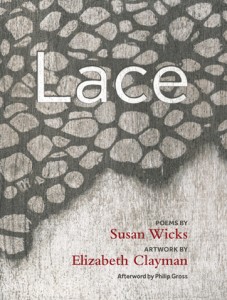If there were ever a case for the physical book over an e-book, Lace is its embodiment. Small is beautiful, in this case: a pamphlet of thirteen short, numbered poems coupled with vine charcoal drawings, made on gessoed wood panels, of tiny scraps of lace held in the ‘hidden’ collections at Tunbridge Wells Museum and Art Gallery.
The collaboration began as part of Re:Collections, a commissioned project involving women writers and visual artists, and there are feminine themes running throughout the work. Process is an important part of collaboration, and recreating the lace fragments in soft vine charcoal and rendering them in words is like the intricacy of the lace-making, traditionally crafted by women.
The physical body, menstrual cycles, ageing and depression are found in Wicks’s responses to the lace, which is described with bodily analogies such as “subcutaneous”, “carious as an old tooth.” What is hidden, like the lace fragments trapped between acid-free tissue paper in the Museum storerooms, is brought to the fore in this pamphlet. The monthly bleeding of the female cycle is explicitly addressed in Poem 6, where “the woman’s body” “bleeds / a juice like sap, its head full of light.” Each “unlived life” leaves:
a cavity for heart
and one for stomach, fraying bag of womb
that moves its lips and lines itself with fur
The image that accompanies the poem reminds me of the texture and feel of Dr White’s sanitary towels, which those of us of a certain age endured wearing as teenagers:
The dark flows downwards. No one sees it leave
and wind away, congeal to a dry skein,
the skein of who she was.
The theme is returned to in the final poem, 13, where the line of the outer edge of the lace is likened to the physical ebb and flow of the sea on the shore, and the menstrual cycle:
Low tide and time
is inching shorewards, crawling, curling its white fingers,
fails,
and fizzes back
and crawls again
Indeed the bleed of the images across the centre line of each double page, onto the poems’ pages, also reflects this theme.
It is the space between the threads that is often addressed, an absence and a presence at once, a fragility preserved, pulled out of shape, reflecting both women’s bodies and the make-do-and-mend mindset historically held by women. The imagined women, the subjects of the poems, see “the shapes of babies’ feet or leaves, or pods of peas” in Poem 7. The first stanza suggests busyness, growth, work, nurturing:
But here at the centre is a torn space
where she can stand and breathe
… a mental space, as well as a physical one, where she can “resurface, plant her body upright like a flag.”
Maria C. McCarthy is the author of As Long as it Takes, a collection of linked short stories (Cultured Llama, 2014) and a poetry collection, Strange Fruits (Cultured Llama 2011). She is the winner of the Society of Authors’ Tom-Gallon Trust Award 2015. www.medwaymaria.co.uk
Buy your copy of Lace by Susan Wicks and Elizabeth Clayman, published by Stonewood Press here: http://www.stonewoodpress.co.uk/product/lace/

